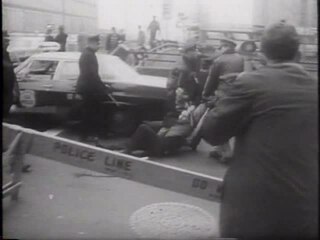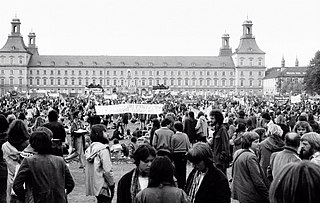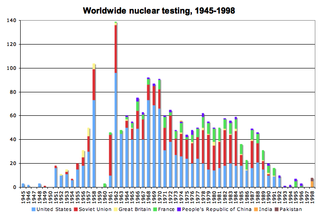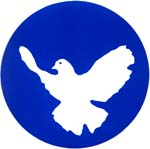
Nuclear disarmament is the act of reducing or eliminating nuclear weapons. Its end state can also be a nuclear-weapons-free world, in which nuclear weapons are completely eliminated. The term denuclearization is also used to describe the process leading to complete nuclear disarmament.
Peace Action is a peace organization whose focus is on preventing the deployment of nuclear weapons in space, thwarting weapons sales to countries with human rights violations, and promoting a new United States foreign policy based on common security and peaceful resolution to international conflicts.

Volker Rühe is a German politician of the Christian Democratic Union (CDU). He served as German Defence minister from 1 April 1992, succeeding Gerhard Stoltenberg during the first government of a reunified Germany in the fourth cabinet of Chancellor Kohl, to the end of the fifth Kohl Cabinet on 27 October 1998. During his time at the Defence Ministry Rühe played a central role in placing NATO enlargement on the German political agenda. He unsuccessfully ran for the office of minister-president of the German state Schleswig-Holstein in the year 2000, eventually losing against incumbent Heide Simonis.

A peace walk or peace march, sometimes referred to as a peace pilgrimage, is a form of nonviolent action where a person or group marches a set distance to raise awareness for particular issues important to the walkers.
The Baruch Plan was a proposal by the United States government, written largely by Bernard Baruch but based on the Acheson–Lilienthal Report, to the United Nations Atomic Energy Commission (UNAEC) during its first meeting in June 1946. The United States, Great Britain and Canada had called for an international organization to regulate atomic energy, and President Truman responded by asking Undersecretary of State Dean Acheson and David E. Lilienthal to draw up a plan. Baruch's version of the proposal was rejected by the Soviet Union, who feared the plan would preserve the American nuclear monopoly. Its collapse led to the beginning of the Cold War arms race.

The anti-nuclear movement is a social movement that opposes various nuclear technologies. Some direct action groups, environmental movements, and professional organisations have identified themselves with the movement at the local, national, or international level. Major anti-nuclear groups include Campaign for Nuclear Disarmament, Friends of the Earth, Greenpeace, International Physicians for the Prevention of Nuclear War, Peace Action, Seneca Women's Encampment for a Future of Peace and Justice and the Nuclear Information and Resource Service. The initial objective of the movement was nuclear disarmament, though since the late 1960s opposition has included the use of nuclear power. Many anti-nuclear groups oppose both nuclear power and nuclear weapons. The formation of green parties in the 1970s and 1980s was often a direct result of anti-nuclear politics.

The Cold War from 1979 to 1985 was a late phase of the Cold War marked by a sharp increase in hostility between the Soviet Union and the West. It arose from a strong denunciation of the Soviet invasion of Afghanistan in December 1979. With the election of Prime Minister Margaret Thatcher in 1979, and American President Ronald Reagan in 1980, a corresponding change in Western foreign policy approach toward the Soviet Union was marked by the rejection of détente in favor of the Reagan Doctrine policy of rollback, with the stated goal of dissolving Soviet influence in Soviet Bloc countries. During this time, the threat of nuclear war had reached new heights not seen since the Cuban Missile Crisis of 1962.

Mutlangen is a town in the German state of Baden-Württemberg in the Ostalbkreis district and belongs to the Stuttgart Metropolitan Region. As of 31 December 2015, it has 6,588 inhabitants.
The Seneca Women's Encampment for a Future of Peace and Justice was a women-only peace camp formed to protest the scheduled deployment of Cruise and Pershing II missiles before their suspected shipment from the Seneca Army Depot to Europe in the fall of 1983.

André Larivière is an ecologist and anti-nuclear activist from Quebec, Canada. He has lived in Europe since 1986 and was a leading speaker for the French Sortir du nucléaire network. In February 2010, he has been elected member of the board of trustees.
1984 Network Liberty Alliance is a loose group of software programmers, artists, social activists and militants, interested in computers and networks and considering them tools to empower and link the various actors of the social movement around the world. They are part of the hacktivism movement.

The anti-nuclear movement in the United States consists of more than 80 anti-nuclear groups that oppose nuclear power, nuclear weapons, and/or uranium mining. These have included the Abalone Alliance, Clamshell Alliance, Committee for Nuclear Responsibility, Nevada Desert Experience, Nuclear Information and Resource Service, Physicians for Social Responsibility, Plowshares Movement, Women Strike for Peace, Nukewatch, and Women's International League for Peace and Freedom. Some fringe aspects of the anti-nuclear movement have delayed construction or halted commitments to build some new nuclear plants, and have pressured the Nuclear Regulatory Commission to enforce and strengthen the safety regulations for nuclear power plants. Most groups in the movement focus on nuclear weapons.
Anti-nuclear organizations may oppose uranium mining, nuclear power, and/or nuclear weapons. Anti-nuclear groups have undertaken public protests and acts of civil disobedience which have included occupations of nuclear plant sites. Some of the most influential groups in the anti-nuclear movement have had members who were elite scientists, including several Nobel Laureates and many nuclear physicists.

A peace movement is a social movement which seeks to achieve ideals such as the ending of a particular war or minimizing inter-human violence in a particular place or situation. They are often linked to the goal of achieving world peace. Some of the methods used to achieve these goals include advocacy of pacifism, nonviolent resistance, diplomacy, boycotts, peace camps, ethical consumerism, supporting anti-war political candidates, supporting legislation to remove profits from government contracts to the military–industrial complex, banning guns, creating tools for open government and transparency, direct democracy, supporting whistleblowers who expose war crimes or conspiracies to create wars, demonstrations, and political lobbying. The political cooperative is an example of an organization which seeks to merge all peace-movement and green organizations; they may have diverse goals, but have the common ideal of peace and humane sustainability. A concern of some peace activists is the challenge of attaining peace when those against peace often use violence as their means of communication and empowerment.

Anti-nuclear protests began on a small scale in the U.S. as early as 1946 in response to Operation Crossroads. Large scale anti-nuclear protests first emerged in the mid-1950s in Japan in the wake of the March 1954 Lucky Dragon Incident. August 1955 saw the first meeting of the World Conference against Atomic and Hydrogen Bombs, which had around 3,000 participants from Japan and other nations. Protests began in Britain in the late 1950s and early 1960s. In the United Kingdom, the first Aldermaston March, organised by the Campaign for Nuclear Disarmament, took place in 1958. In 1961, at the height of the Cold War, about 50,000 women brought together by Women Strike for Peace marched in 60 cities in the United States to demonstrate against nuclear weapons. In 1964, Peace Marches in several Australian capital cities featured "Ban the Bomb" placards.

The application of nuclear technology, both as a source of energy and as an instrument of war, has been controversial.
Stellan Vinthagen is a professor of sociology, a scholar-activist, and the Inaugural Endowed Chair in the Study of Nonviolent Direct Action and Civil Resistance at the University of Massachusetts, Amherst, where he directs the Resistance Studies Initiative. He is also Co-Leader of the Resistance Studies Group at University of Gothenburg and co-founder of the Resistance Studies Network, as well as Editor of the Journal of Resistance Studies, and a Council Member of War Resisters International (WRI), and academic advisor to the International Center on Nonviolent Conflict (ICNC). His research is focused on resistance, power, social movements, nonviolent action, conflict transformation and social change. He has since 1980 been an educator, organizer and activist in several countries, and has participated in more than 30 nonviolent civil disobedience actions, for which he has served in total more than one year in prison.

The Pershing II Weapon System was a solid-fueled two-stage medium-range ballistic missile designed and built by Martin Marietta to replace the Pershing 1a Field Artillery Missile System as the United States Army's primary nuclear-capable theater-level weapon. The U.S. Army replaced the Pershing 1a with the Pershing II Weapon System in 1983, while the German Air Force retained Pershing 1a until all Pershings were eliminated in 1991. The U.S. Army Missile Command (MICOM) managed the development and improvements, while the Field Artillery Branch deployed the systems and developed tactical doctrine.
The Nuclear Freeze campaign was a mass movement in the United States during the 1980s to secure an agreement between the U.S. and Soviet governments to halt the testing, production, and deployment of nuclear weapons.












